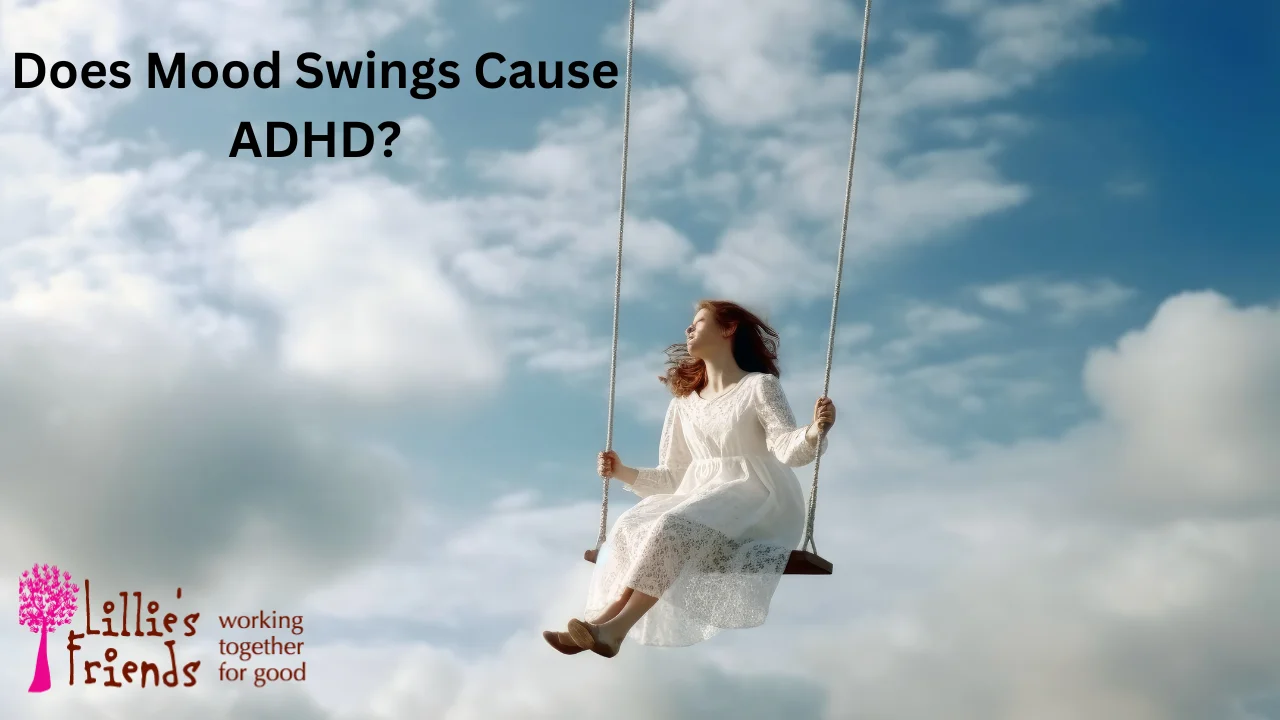Highlights
- Extreme mood swings are definitely associated with attention deficit hyperactivity disorder (ADHD), though there are a number of contributing factors.
- ADHD mood swings may be brought on by the disorder itself, co-occurring disorders, or adverse drug reactions.
- Making lifestyle adjustments, using coping mechanisms to manage stress, and consulting a physician if elevated emotions are interfering with day-to-day functioning are all ways to manage mood swings associated with ADHD.
- Mood swings are a common symptom of ADHD, though they are not necessary for the diagnosis.
Are you at your wits’ end attempting to control your mood swings due to ADHD by yourself?
When hyperactivity and difficulties concentrating are discussed, most people associate it with certain features. A few less well-known symptoms, meanwhile, may appear in patients with the illness. Mood swings are one example, which are sometimes linked to psychiatric problems other than ADHD.
This book discusses the connection between mood swings and ADHD and offers coping mechanisms for emotional highs and lows.

Do Mood Swings Cause ADHD?
While not all ADHD individuals have powerful emotional responses that might impact their mood, the majority do. Research ↗ indicates that emotional dysregulation is a common problem for both adults and children with ADHD. Patients may have trouble controlling their intense feelings. Meltdown episodes and reactive mood swings may arise from this fight.
Other ADHD symptoms may also cause the person with ADHD to get agitated and experience overwhelming emotions, such as difficulty concentrating or being quickly distracted. These indicators have the potential to swiftly lower mood and increase irritation.
Occasionally, emotional outbursts follow mood fluctuations associated with ADHD. Impulsivity, a defining sign of the condition, explains this.
ADHD symptoms Changes in Mood
The following patterns may help you identify your highs and lows with ADHD:
- Experiencing emotional outbursts under pressure
- Being agitated as a result of restlessness and hyperactivity
- Saying things that aren’t appropriate for a given circumstance
- Acting aggressively or violently
- Experiencing emotions more strongly than is suitable for a given circumstance
- Experiencing increased distress due to strong emotions, which creates a vicious cycle
- Displaying irregular sleep habits
- Changing in a matter of hours from a high emotion, such as excitement, to a low one, such as despair
- Looking energized one minute and worn out the next
- Changing from feeling energized to feeling worn out
- Easily losing your temper
Next, we’ll examine how these and other factors affect the link between mood swings and ADHD.
How Can Mood Swings Caused by ADHD Be Handled?
Treating mood instability in adult patients may be a component of their ADHD treatment plan. There are several resources available to assist you with this procedure. As you learn to regulate your mood, you could find it easier to handle your interactions and that your confidence grows in the ways that are described below.
Dissatisfaction With Insufficient Attention
Poor working memory and executive function are known to contribute to low frustration tolerance in people with ADHD. It may sound pretentious, but it simply means that they are too distracted by their surroundings to concentrate, prioritize tasks, or act fast.
It makes sense that such behaviors could result in mood swings, anxiety, irritability, and frustration.
Inadequate Impulse Control
One of the main signs of ADHD is poor impulse control. In addition to disrupting conversations and making it difficult to wait in line, a lack of self-control can also result in extreme mood swings, tears, irritability, and frustrated outbursts.
High Vitality
Hyperactivity is another hallmark symptom of ADHD that can lead to mood swings. High-energy individuals with ADHD often exhibit high levels of energy and may experience emotional peaks.
Dysphoria Sensitive to Rejection
An emotional turmoil reaction brought on by a strong feeling of rejection is known as rejection-sensitive dysphoria (RSD); in other words, an intense, protracted overreaction to assumed rejection. People with ADHD may be more sensitive to rejection because they are more likely to suffer from emotional dysregulation and frequently face rejection when they don’t fit in.
Drugs.
Unbelievably, the ADHD medication that is typically used to treat the disorder can occasionally be the cause of the severe mood swings associated with ADHD.
For many individuals with ADHD, methylphenidate or stimulants derived from amphetamines are the first-line treatment, if appropriate. Regretfully, anxiety is a recognized adverse effect of this class of drugs, which can lead to mood swings and a reduced ability to handle stress.
Mood disorders and other mental health conditions that co-occur
Co-occurring (comorbid) conditions can also lead to elevated emotions. Extreme mood swings can be a symptom of a number of mental health conditions, including
- Disorders of anxiety
- Mood disorders, such as depression and bipolar disorder, ↗
- Personality disorders
- PTSD, or post-traumatic stress disorder
Since anxiety disorders affect 1 in 4 people with ADHD ↗, they deserve special attention. An overly reactive or erratic mood is one of their symptoms, especially those of generalized anxiety disorder (GAD).
Emotions can range from normal to ecstatic, angry, or violent, then plummet to tears and despair.
Compared to their male counterparts, females with ADHD are more likely to have comorbid mental health conditions. This is due to their tendency to be distracted, disorganized, and forgetful, and they are more likely to have inattentive ADHD. Males with ADHD, on the other hand, are typically more impulsive and hyperactive, which is readily apparent.
Women with ADHD often conceal their inattentive symptoms due to this “quieter presentation,” which can:
- Impact their psychological health
- Result in a later diagnosis of ADHD ↗.
Adult mood swings in women with ADHD may be exacerbated by untreated ADHD and potential co-occurring anxiety and depression.
Now that you know why, let’s examine the possible manifestations of mood swings in ADHD.
The Effects of Mood Variations
People often view adult mood swings as unacceptable, and regrettably, they can have negative effects in a variety of spheres of life.
- Work: Adults with ADHD who frequently cry or lose their temper at work risk disciplinary hearings, bitter coworkers, or even losing their jobs.
- Relationships at Home: Frequent mood swings are exhausting to cope with, even if family members or loved ones are aware of an ADHD diagnosis. Relationships will inevitably become strained.
7 Strategies for Handling ADHD Mood Swings
Using stress-reduction techniques and altering one’s lifestyle are excellent ways to manage mood swings associated with ADHD.
1. Consistent Exercise
One promising strategy for improving attention in ADHD ↗ is physical exercise, which can help avoid frustration and potentially mood swings. Such exercise could entail walking on a treadmill or pedaling a stationary bike during the workday, but exercising outside is preferable.
2. Taking Time Outside
Being outside has two benefits and may be a natural remedy. Firstly, studies have shown that green spaces such as parks and forests can alleviate symptoms of anxiety and potentially ADHD. Second, exposure to sunlight improves the quality of your sleep by regulating your circadian rhythm.
3. A Healthful Diet
Let’s look at how diet affects mood swings in ADHD. Eating a balanced diet is crucial for both the brain and overall physical health. People with ADHD should limit sugars and simple carbs because they are more likely to gain weight. ↗ Being overweight may exacerbate rejection-sensitive dysphoria and lead to a negative self-image.
The few-foods diet ↗ takes into account theories that some foods, such as sugar, may cause ADHD. To find the dietary trigger, the participant removes the majority of foods from the diet and then gradually adds them back one at a time. Six out of ten children in a study showed improvement, so if you believe that diet is a factor in your ADHD, you might want to look into it.
4. Restful Sleep
In individuals with ADHD, sleep issues, such as disturbed or insufficient sleep, are thought to exacerbate poor emotional regulation and affect mood.
5. Traveling
Seeing your emotions on paper helps you process them. It’s simpler to regulate your emotions and lessen your mood swing if you know what’s causing it. Journaling also has the potential to identify particular triggers for mood swings.
6. Being Aware of Your Triggers
One of the best ways to manage mood swings caused by ADHD is to identify and stay away from your triggers while you research treatment options.
7. Being mindful
To be mindful ↗, you must intentionally focus on your feelings at a given point without passing judgment. You then learn how to relax and breathe to change those feelings and regain control.
However, you should consult a healthcare provider if your mood swings are affecting your everyday life and general well-being. You can get in touch with a skilled professional who will evaluate your symptoms and develop a customized plan to help you manage ADHD and its emotional effects through Lillie’s Friends online ADHD treatment.
Treatment Guided by Healthcare Professionals
To manage both ADHD and any comorbid conditions that may be contributing to your mood swings, your healthcare provider will select a treatment plan. This plan will typically include either medication, therapy, or both.
Counseling
CBT, or cognitive-behavioral therapy, helps people with ADHD who have mood swings. Because mood affects behavior and thoughts affect mood, cognitive behavioral therapy (CBT) teaches you how to alter your feelings about a thought, which alters behavior. Negative thoughts are then perceived differently, leading to either neutral or positive reactions.
Drugs
Medication control is typically required when mood swings are severe. Your doctor will see if you have ADHD alone or with other mental health issues.
Stimulants, which are the first-line treatments for ADHD, can regrettably make some patients feel more anxious. Don’t worry, though; non-stimulants are substitutes. Additionally, your doctor may prescribe antidepressants if you also have anxiety or mood disorders.
To sum up
If intrusive thoughts are affecting your quality of life, speaking with a healthcare professional is the best way to get rid of them. They can diagnose you with OCD, PTSD, anxiety disorder, or depression; evaluate your symptoms; and rule out underlying conditions. By scheduling an appointment at Lillie’s Friends, you can see a qualified healthcare professional and complete such an evaluation in as little as 24 hours.
FAQs
Does ADHD cause unstable moods?
Indeed, mood swings can be a symptom of attention deficit hyperactivity disorder (ADHD). If mood swings start to cause you discomfort or have a big impact on your life, it's critical to get help.
Are mood swings a symptom of ADHD?
Although they are not required for the diagnosis of ADHD, mood swings are frequently linked to the disorder.
What triggers ADHD mood swings?
Poor emotional control, impulsive outbursts, low frustration tolerance due to inattentiveness, and hyperactivity that occasionally results in irritation are common causes of mood swings in ADHD.
What do ADHD mood swings look like?
Any significant emotional shift from one moment to the next, whether it be through intense feelings, inappropriate behavior, or changes in energy levels, is referred to as an ADHD mood swing. For instance, but not exclusively:
- Sadness (feeling worn out) and joy (feeling energized)
- Anger (a violent outburst) and regret (totally withdrawing from others)
- Excitement and despair
- Irritable and neutral
How long do ADHD mood swings last?
The duration of an ADHD mood swing varies from person to person and is influenced by the severity of ADHD, the efficacy of treatment, life events, mood triggers, and co-occurring conditions.











